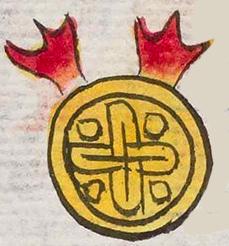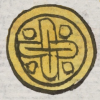Teocuitlatlan (Mdz13v)
This compound glyph represents the place name, Teocuitlatlan. The primary feature is the gold disc (teocuitlatl), which appears to be on fire. The flames stand for the verb to burn (tlatla). Each flame has three points, and it is primarily red with an orange or yellow base. The gold disc has a cross (+) and four dots, one between each finger of the cross.
Stephanie Wood
The flames provide a phonetic reinforcement of the ending of the place name—-the final syllable of "teocuitla" plus the locative suffix (-tla(n)). Gordon Whittaker explains this as "sylleptic play" in his recent book Deciphering Aztec Hieroglyphs (2021).
Stephanie Wood
teocuitlatlā. puo
Teocuitlatlan, pueblo
Stephanie Wood
c. 1541, or by 1553 at the latest
Stephanie Wood
gold, gold discs, gold pieces, flames, fire, burning, burns, nombres de lugares

teocuitla(tl), gold, a piece of gold, https://nahuatl.wired-humanities.org/content/teocuitlatl
tlatla, to burn, https://nahuatl.wired-humanities.org/content/tlatla
-tlan (locative suffix), https://nahuatl.wired-humanities.org/content/tlan
"Place of Much Gold" (Berdan & Anawalt, 1992, v. 1, p. 208)
TEOCUITLAtlatlan
Codex Mendoza, folio 13 verso, https://digital.bodleian.ox.ac.uk/objects/2fea788e-2aa2-4f08-b6d9-648c00..., image 37 of 188.
The Bodleian Libraries, University of Oxford, hold the original manuscript, the MS. Arch. Selden. A. 1. This image is published here under the UK Creative Commons, “Attribution-NonCommercial-ShareAlike 3.0 License” (CC-BY-NC-SA 3.0).



